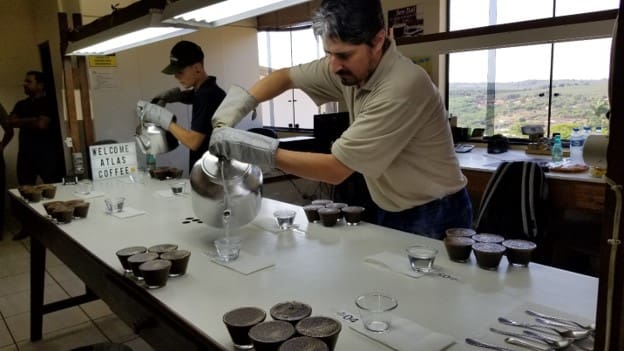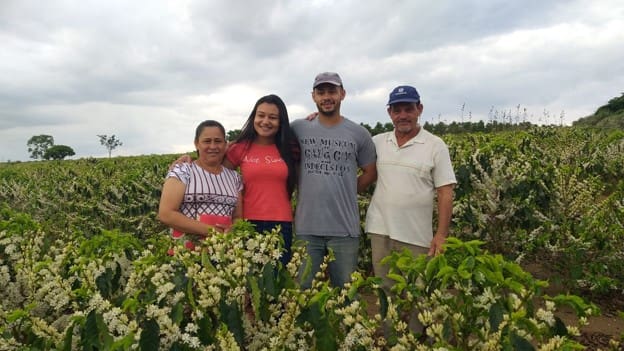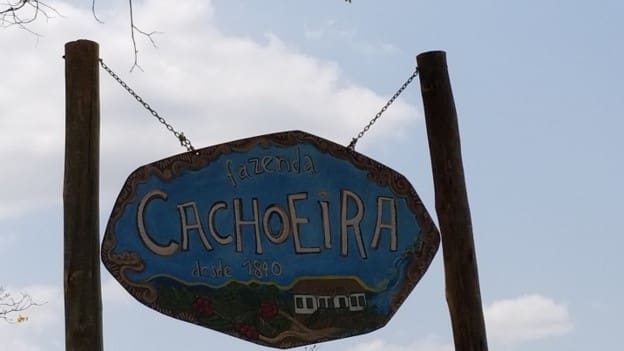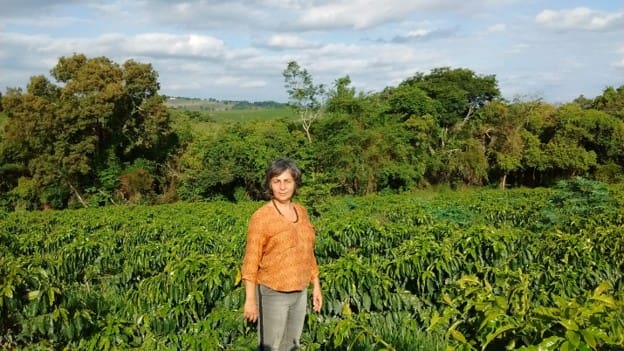Brazil is home to an incredible diversity of flavor profiles from both small holders of only a few hectares all the way up to massive estates of over a thousand hectares.
In September of 2019, we returned to Brazil to visit with our producer partners. Santo Antonio Estates, a cooperative in Minas Gerais state in southeastern Brazil was our first stop.
Santo Antonio Estates (SanCoffee)
SanCoffee is a collective of 20 medium-to-large scale estates utilizing sophisticated farming and processing techniques, centralized around the town of Santo Antonio do Amparo. Our partnership began when Atlas was introduced to SanCoffee president Henrique Dias Cambraia at the 2007 SCA conference. That fortuitous meeting led to a 13-year long relationship making it one of Atlas’ most enduring partnerships.
Microlot cupping at SanCoffee’s lab
The group specializes in natural and pulped natural processing and our Estate Classic, Flor de Ipe Espresso Blend and Samambaia Yellow Bourbon all come from SanCoffee. By combining excellent farming, harvest and post-harvest techniques with extremely efficient processing methods, logistics and management systems, SanCoffee consistently supplies high quality blends. In addition to their blended lots, the group has also gained international recognition for exceptional micro-lots. Producers from SanCoffee can often be found on the list of finalists and winners in Brazil’s yearly Cup of Excellence cupping competition.
Emphasizing sustainability, traceability and quality over quantity has been a winning strategy for SanCoffee’s 20 members over the years. In 2013, SanCoffee began their Beyond the Borders project which provides many of the same benefits it offers its own members to growers outside of the group. SanCoffee provides technical and agronomical training in order to improve quality and productivity, while providing the milling, drying, and quality control through their well-equipped cupping lab. They also provide other important aspects of the supply chain such as documentation, warehousing and exporting.
The Beyond the Borders initiative first began with an association of producers with an average farm size of only 5 hectares called AFASA (Associação dos Agricultores Familiares de Santo Antônio do Amparo).
For many years, small-scale producers in the town of Santo Antonio do Amparo found themselves cut off from international markets and were forced to sell their coffee as ungraded bica corrida to local dealers at a low price. As a result, they had little incentive to work towards producing specialty coffee.
Jennifer Roberts of Atlas was introduced to AFASA in 2013 through our relationship with SanCoffee. She encouraged the group to increase the care given to cherry selection and post-harvest processing. In so doing, they could leverage their smaller volume and use it to their advantage while also benefiting from SanCoffee’s economies of scale. She started a pilot project for microlots and shortly after, Atlas returned with buyers and the first AFASA microlot cupping competition was born.
2019 marked our 5th microlot cupping competition with AFASA and it was inspiring to see how far the group has come. Quality from AFASA has improved dramatically in a short time and each year brings exciting new microlots.
2019 AFASA Cupping Competition Winner Domingo Savio de Oliveira (far right) and his family
The 2019 winning lot comes from farmer Domingo Savio de Oliveira. Domingo produces about 15 bags a year on his 3-hectare farm. Domingo produced his winning Catucai microlot with great care utilizing an anaerobic fermentation process. Cherries were hand-picked to ensure perfect maturity. They were then placed in a hermetically sealed container allowing for a high level of control over sugar level, pH and temperature. The fermentation process occurred over 5 days in this oxygen-free environment. The cherries were then dried slowly on the patio for 15 days. The resulting cup was complex with bright strawberry-like acidity, cherry sweetness, and lush toffee and spice finish.
Our visit left us encouraged about the exceptional progress the group is making and we can’t wait to return next year and see all that our friends have accomplished.
Our next stop was to visit one of the oldest and most beautiful coffee estates in the Campos das Vertentes region.
Visiting the nearly 200-year-old farm of Miriam Monteiro de Aguiar is a bit like stepping back in time. Miriam’s family home has changed little since the farm was first established in 1840. Fazenda Cachoeira (meaning “waterfall”), is owned and operated by 6th generation Coffee producer Miriam Monteiro de Aguiar. Among the finest producers of organic micro-lots in Brazil, Miriam has dedicated her life to sustainable and biodynamic agriculture.
In a country dominated by large-scale chemical dependent farming, it’s exciting to see smaller farms like Fazenda Cachoeira bolstering the reputation of organic micro-lots from Brazil and inspiring other producers to follow suit. Miriam shares her extensive knowledge with producers by holding workshops on sustainable farming practices and quality control at Fazenda Cachoeira. She is especially interested in helping other women producers get their start and is a highly visible advocate for women in Brazil’s coffee industry by serving as a member of the Brazilian chapter of the IWCA (International Women Coffee Alliance).
Coffee defect classification class held at Fazenda Cachoeira
We visited Miriam during a time of extensive drought in southern Minas Gerais. We spent the day cupping truly delicious coffees and learning about the fascinating history of Fazenda Cachoeira. In the evening, we rode horses through the rows of coffee trees with dark clouds off in the distance. As we said our goodbyes, heavy rains finally fell over the parched landscape after over 40 days without rain.
It’s hard to believe that the start of Brazil’s next harvest is only a few months away. Planning is already underway for our next trip and we can’t wait to return to see what all our producer partners have accomplished.




